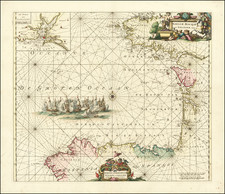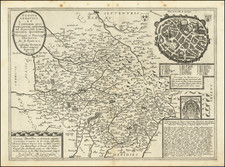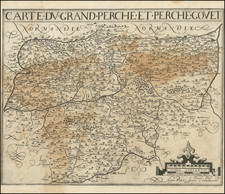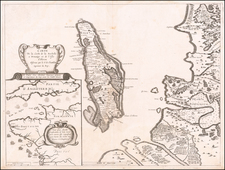In the Waters off Brittany, The Royal Navy Seals the Fate of the American Colonies.
"The 1759 Battle at Quiberon Bay established Britain as the world’s dominant naval power and changed the course of North American history." (Lyons, Naval History Magazine)
This fine, large, hand-drawn English map of the Battle of Quiberon Bay stands as one of the best contemporary representations of one of the most important naval battles of the 18th century. The Battle of Quiberon Bay, fought on November 20, 1759, during the Seven Years' War, was a decisive naval engagement in which the British Royal Navy, commanded by Sir Edward Hawke, defeated the French fleet near the coast of Brittany, France. This victory prevented a French invasion of Britain, secured British naval dominance for the remainder of the war, and significantly hindered France's ability to reinforce its colonies in North America.
This remarkable large map was evidently "taken on board his Majesty's ship the Kingston at an Anchor in Quberon [sic] Bay January 2d: 1760." Dated approximately six weeks after the battle, the map was evidently drawn by one of the crew of the HMS Kingston, commanded by Thomas Shirley. The map is a remarkable compilation, providing an exceptional overview of the Bay and outlying islands and neighboring towns, with meticulous detail given to the combatant ships, several of which are shown ablaze or sunk, with crew members in the water or jumping from the upper masts of ships. The drawing also shows evidence of its composition and progress, with some of the British offshore fleet still in preparatory pencil outline.
Coastal details include soundings, anchorages, shoals, and rocks, along with profiles of larger buildings along the mainland coastline and on Belle Isle, "Quberon" Island, with town plan grids shown for the larger towns.
The note on the verso reads "The Hon:ble Sir Edward Hawkes Engagement wth. Conflans 1759 shows the Land Lay." A small section of the paper was lifted from the board backing to read the docketing (see illustration).
Battle of Quiberon Bay
The Battle of Quiberon Bay was a defining naval engagement during the height of the Seven Years' War. This confrontation saw an array of British and French ships-of-the-line locked in fierce combat, with the result - a decisive British victory - fundamentally altering the trajectory of global naval dominance. The battle occurred on November 20, 1759, within the confining and perilous waters of Quiberon Bay, studded with hazardous rocks and shoals. The battle featured the catastrophic sinking of nine vessels and the deaths of approximately 3,700 sailors.
Naval historian Alfred Thayer Mahan, in his analyses, revered the Battle of Quiberon Bay as the pivotal naval engagement of the Seven Years’ War, likening its impact to that of the Battle of Trafalgar years later. The British triumph irrevocably damaged French maritime power, securing British supremacy at sea and thwarting any imminent threats of invasion against the British Isles. Consequently, this victory not only reshaped the European power landscape but also sealed the fate of colonial territories in North America.
The events leading to this monumental clash began to unravel with the British capture of Louisbourg in July 1758, thereby controlling the strategic gateway to the St. Lawrence River. This significant loss for France was compounded by the subsequent British victory at Quebec in September 1759. French military strategies aimed at diverting British forces from North America were systematically dismantled by British naval prowess, notably through Rear Admiral George Brydges Rodney's successful raid on Le Havre and Admiral Edward Boscawen's decisive defeat of the French Mediterranean fleet at the Battle of Lagos. The cumulative effect of these setbacks, including the British conquest of Guadeloupe, severely depleted French resources and thwarted their plans for an expansive invasion of England and Scotland.
The French naval contingent, led by Admiral Hubert de Brienne, Comte de Conflans, intended to launch a retaliatory campaign from Brest towards Scotland. Despite the stringent British blockade orchestrated by Sir Edward Hawke and Lord George Anson, Conflans advanced his fleet toward Quiberon Bay, aiming to amalgamate with allied transport ships for a Scottish invasion.
The British naval blockade, a testament to the strategic ingenuity of Sir Edward Hawke, Admiral of the Channel Fleet, and Lord George Anson, First Lord of the Admiralty, was pivotal in constraining French naval operations. The blockade's efficacy was demonstrated by the persistent presence of British forces along the French coast, despite adverse weather conditions. Hawke, renowned for his lifetime of service in the Royal Navy and lauded by Mahan as a seminal figure in British naval history, had been maintaining the blockade since June. Yet, as a severe storm approached the Brittany coast on November 7, 1759, his flagship, the Royal George, was compelled to seek refuge, leaving Captain Robert Duff with a contingent of ships to continue the blockade.
The French, seizing the momentary lapse in British vigilance, under the command of Admiral Jean-Baptiste-François Bompart, managed to reinforce their fleet at Brest, setting the stage for the impending confrontation. Bompart's arrival bolstered Conflans' fleet, allowing them to discreetly embark from Brest on an easterly wind on November 14. The British, upon realizing the French movement, embarked on a relentless pursuit led by Hawke, culminating in the encounter at Quiberon Bay.
During the battle, Admiral Hawke's disregard for conventional naval protocols allowed the British fleet to engage the French under challenging conditions, demonstrating superior seamanship and tactical acumen. The British ships, including Captain Robert Duff’s squadron, displayed unparalleled bravery and strategic foresight, confronting the French fleet amid the hazardous bay.
The fierce combat resulted in significant losses on both sides. French vessels, including the 74-gun Thésée and the 74-gun Héros, faced devastating outcomes against the British fleet's formidable might. The Thésée succumbed to the tumultuous sea after a fierce engagement with the British 90-gun Torbay, while the Héros, severely battered, witnessed the demise of its entire officer cadre.
Admiral Conflans, aboard his flagship, the 80-gun Soleil Royal, faced the indomitable British flagship Royal George, commanded by Hawke. This critical encounter between the two flagships epitomized the intense struggle for naval supremacy. Despite the French efforts to protect their commander, the Soleil Royal was ultimately forced aground, leading to Conflans’ decision to set the ship ablaze rather than allow its capture.
The aftermath of the battle revealed the scale of French defeat. Conflans' strategic miscalculations and the subsequent disarray among the French fleet underscored the magnitude of the British victory. The Royal Navy's relentless pursuit and the audacious tactics employed by Hawke and his officers fundamentally altered the outcome of the Seven Years’ War, cementing British naval dominance.
The Battle of Quiberon Bay As A Profound Shift of Naval Tactics
The conclusive engagement within Quiberon Bay not only resulted in significant French naval losses but also marked a critical shift in naval strategies. British forces, exemplified by the courageous actions of ships such as the Revenge, which boldly engaged the French 80-gun Formidable, and the Magnifique, underscored the effectiveness of aggressive tactics over conventional line-of-battle methods. The Revenge’s assault caused considerable damage to the Formidable, while the Magnifique suffered the loss of critical masts in the melee.
Further highlighting the British valor were ships like the Dorchester, which engaged multiple French vessels, and the combined efforts of the Magnanime, Montague, and Warspite, despite encountering navigational challenges. The intense squall and the subsequent chaos led to pivotal moments such as the Chichester losing her foretopsail yard and the consequential damage to other British vessels, which, however, did not deter their pursuit.
The relentless British advance culminated in significant French casualties and the capture of key vessels. The Formidable, once a symbol of French naval strength, was dramatically overtaken after enduring severe damage, a testament to the fierce British offensive. The tragic loss of Rear-Admiral St. André du Verger aboard the Formidable highlighted the high stakes and human cost of this naval warfare.
As the battle reached its zenith, the British continued to harry the French fleet, leading to the grounding and subsequent destruction of the Soleil Royal and other French ships. Admiral Conflans’ decision to scuttle his flagship rather than surrender epitomized the desperation and total defeat of the French naval forces.
The Aftermath of Quiberon Bay
In the aftermath, the Royal Navy’s supremacy was unmistakable. The “great French fleet was annihilated,” as Mahan noted, marking a decisive end to French maritime ambitions and securing British naval hegemony. This victory, while immediate in its physical toll, had far-reaching implications, contributing to the overall British successes of 1759, famously known as the "Annus Mirabilis."
The post-battle period saw Admiral Hawke elevated to a position of national heroism, his bold strategies and naval prowess celebrated across Britain. Conversely, Admiral Conflans faced severe criticism and disgrace in France, his naval career marred by the defeat. The aftermath of Quiberon Bay reshaped naval history, influencing tactics, strategies, and the global balance of power.
The broader implications of the battle extended into the colonial theaters, particularly in North America. The French defeat at Quiberon Bay significantly weakened their ability to sustain their military campaigns overseas. This naval defeat, coupled with losses on land, notably the fall of Quebec, presaged the collapse of French colonial ambitions in North America. The British victory in the battle directly contributed to the British conquests in Canada, culminating in the capitulation of Montreal and the cessation of major French military operations in North America.
Moreover, the outcome of the battle influenced the subsequent diplomatic negotiations and treaties. The shift in naval power dynamics was a crucial factor in the British negotiation position during the Treaty of Paris in 1763. The loss of French naval capability, a direct consequence of the battle, meant that France was significantly handicapped in protecting its overseas colonies, leading to substantial territorial concessions to Britain, including significant parts of North America, Africa, and India.
The psychological impact of the battle on the French naval and military psyche was profound. The defeat not only curtailed French maritime aspirations but also instilled a sense of caution in French naval strategy for years to come. Conversely, the victory bolstered British naval confidence and doctrine, influencing British naval tactics and strategy well into the future.
Notably, the cultural and historical legacy of the Battle of Quiberon Bay has been significant. The battle has been memorialized in British naval lore, commemorated in songs such as "Hearts of Oak" and celebrated in numerous historical accounts. The victory was seen not just as a triumph over the French but as a testament to British naval ingenuity, bravery, and superiority.
List of British Ships
Here are the details for each ship with ship names in bold and italics:
- Royal George: 100 guns, Commander John Campbell, 880 men, Notes: Flagship of Sir Edward Hawke.
- Union: 90 guns, Commander Thomas Evans, 770 men, Notes: Flagship of Sir Charles Hardy.
- Duke: 80 guns, Commander Samuel Graves, 800 men.
- Namur: 90 guns, Commander Matthew Buckle, 780 men.
- Mars: 74 guns, Commander Commodore James Young, 600 men.
- Warspite: 74 guns, Commander Sir John Bentley, 600 men.
- Hercules: 74 guns, Commander William Fortescue, 600 men.
- Torbay: 74 guns, Commander Augustus Keppel, 600 men.
- Magnanime: 74 guns, Commander Viscount Howe, 600 men.
- Resolution: 74 guns, Commander Henry Speke, 600 men, Notes: Wrecked on Le Four shoal.
- Hero: 74 guns, Commander George Edgcumbe, 600 men.
- Swiftsure: 70 guns, Commander Sir Thomas Stanhope, 520 men.
- Dorsetshire: 70 guns, Commander Peter Denis, 520 men.
- Burford: 70 guns, Commander James Gambier, 520 men.
- Chichester: 70 guns, Commander William Saltren Willet, 520 men.
- Temple: 70 guns, Commander Washington Shirley, 520 men.
- Essex: 64 guns, Commander Lucius O'Brien, 480 men, Notes: Wrecked on Le Four shoal.
- Revenge: 64 guns, Commander John Storr, 480 men.
- Montague: 60 guns, Commander Joshua Rowley, 400 men.
- Kingston: 60 guns, Commander Thomas Shirley, 400 men.
- Intrepid: 60 guns, Commander Jervis Maplesden, 400 men.
- Dunkirk: 60 guns, Commander Robert Digby, 420 men.
- Defiance: 60 guns, Commander Patrick Baird, 420 men.
- Rochester: 50 guns, Commander Robert Duff, 350 men.
- Portland: 50 guns, Commander Mariot Arbuthnot, 350 men.
- Falkland: 50 guns, Commander Francis Samuel Drake, 350 men.
- Chatham: 50 guns, Commander John Lockhart, 350 men.
- Venus: 36 guns, Commander Thomas Harrison, 240 men.
- Minerva: 32 guns, Commander Alexander Hood, 220 men.
- Sapphire: 32 guns, Commander John Strachan, 220 men.
- Vengeance: 28 guns, Commander Gamaliel Nightingale, 200 men.
- Coventry: 28 guns, Commander Francis Burslem, 200 men.
- Maidstone: 28 guns, Commander Dudley Digges, 200 men.











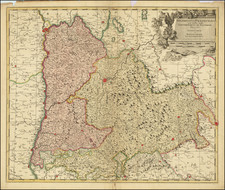
![(Wines of Cognac) Carte des crus du Cognac [Map of Cognac Crus]](https://storage.googleapis.com/raremaps/img/small/89613.jpg)
